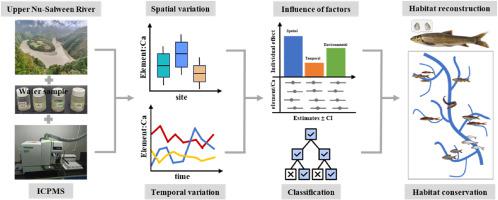当前位置:
X-MOL 学术
›
Environ. Res.
›
论文详情
Our official English website, www.x-mol.net, welcomes your feedback! (Note: you will need to create a separate account there.)
Spatiotemporal variability and drivers of water microchemistry in the upper Nu-Salween river: With implications for fish habitat conservation
Environmental Research ( IF 8.3 ) Pub Date : 2024-03-25 , DOI: 10.1016/j.envres.2024.118754 Bangli Tang , Chengzhi Ding , Liuyong Ding , Yongtao Zhao , Mengxue Zhang , Juan Tao
Environmental Research ( IF 8.3 ) Pub Date : 2024-03-25 , DOI: 10.1016/j.envres.2024.118754 Bangli Tang , Chengzhi Ding , Liuyong Ding , Yongtao Zhao , Mengxue Zhang , Juan Tao

|
Microchemical maps, also known as “chemoscapes”, hold immense potential for reconstructing fish habitat utilization and guiding conservation efforts. This approach relies on matching the microchemical composition of fish calcified structures (e.g., otoliths) with the surrounding water's microchemistry. However, applying this method faces a major challenge: a clear understanding of the spatiotemporal variability and drivers of water microchemistry, particularly in vast, free-flowing river ecosystems like the Nu-Salween River, Southeast Asia's longest free-flowing river. We analyzed the spatiotemporal variability and influencing factors of water microchemistry (i.e., Na:Ca, Mg:Ca, Mn:Ca, Cu:Ca, Zn:Ca, Se:Ca, Sr:Ca, and Ba:Ca) in the upper Nu-Salween River, based on a two-year sampling. Five elemental ratios (excluding Na:Ca, Mg:Ca, and Zn:Ca) in water demonstrated significant spatiotemporal variability, with Cu:Ca having the largest spatial variation, and Mn:Ca and Sr:Ca showing the greatest temporal variation. More specifically, four elemental ratios (Cu:Ca, Se:Ca, Sr:Ca, and Ba:Ca), exhibited significant variations along the longitudinal gradient, and Mn:Ca, Cu:Ca, Sr:Ca, and Ba:Ca, showed significant differences between mainstreams and tributaries. Temporally, Mn:Ca, Cu:Ca, and Ba:Ca displayed higher values and variations during the wet season, opposing the seasonal patterns of Na:Ca, Mg:Ca, and Sr:Ca. The four-element (Ba:Ca, Sr:Ca, Mg:Ca, and Mn:Ca) forest model showed the highest classification accuracy of 93%. Linear mixed-effects models showed that spatial factors have the largest influence on the variances in water microchemistry (56.36 ± 28.64%). Our study highlights the feasibility and reliability of utilizing microchemistry to reconstruct fish habitat utilization, thereby unveiling promising avenues for a more accurate understanding of fish life history in large rivers characterized by high heterogeneity in water microchemistry. By proportionally accounting for contribution of different factors to water microchemistry variability and relating them to microchemical composition of fish calcified structures, key fish habitats (e.g., spawning grounds) and migratory routes can be more precisely identified and thus protected.
中文翻译:

萨尔温江上游水微化学的时空变化和驱动因素:对鱼类栖息地保护的影响
微化学图,也称为“化学景观”,在重建鱼类栖息地利用和指导保护工作方面具有巨大潜力。这种方法依赖于将鱼类钙化结构(例如耳石)的微化学成分与周围水的微化学成分相匹配。然而,应用这种方法面临着一个重大挑战:清楚地了解水微化学的时空变化和驱动因素,特别是在广阔的自由流动的河流生态系统中,例如东南亚最长的自由流动河流怒萨尔温江。我们分析了上层水体微化学(即Na:Ca、Mg:Ca、Mn:Ca、Cu:Ca、Zn:Ca、Se:Ca、Sr:Ca和Ba:Ca)的时空变化和影响因素。怒江萨尔温江,基于两年的采样。水中的五种元素比(不包括Na:Ca、Mg:Ca和Zn:Ca)表现出显着的时空变化,其中Cu:Ca具有最大的空间变化,Mn:Ca和Sr:Ca显示出最大的时间变化。更具体地说,四种元素比率(Cu:Ca、Se:Ca、Sr:Ca 和 Ba:Ca)沿纵向梯度表现出显着变化,并且 Mn:Ca、Cu:Ca、Sr:Ca 和 Ba:Ca , 主流和支流之间表现出显着差异。从时间上看,Mn:Ca、Cu:Ca 和 Ba:Ca 在雨季表现出较高的值和变化,与 Na:Ca、Mg:Ca 和 Sr:Ca 的季节性模式相反。四元素(Ba:Ca、Sr:Ca、Mg:Ca 和 Mn:Ca)森林模型的分类准确率最高,达到 93%。线性混合效应模型表明,空间因素对水微化学变化的影响最大(56.36 ± 28.64%)。我们的研究强调了利用微化学重建鱼类栖息地利用的可行性和可靠性,从而为更准确地了解以水微化学高度异质性为特征的大河流中鱼类的生活史提供了有希望的途径。通过按比例考虑不同因素对水体微化学变异性的贡献并将其与鱼类钙化结构的微化学成分相关联,可以更精确地识别并保护关键鱼类栖息地(例如产卵场)和洄游路线。
更新日期:2024-03-25
中文翻译:

萨尔温江上游水微化学的时空变化和驱动因素:对鱼类栖息地保护的影响
微化学图,也称为“化学景观”,在重建鱼类栖息地利用和指导保护工作方面具有巨大潜力。这种方法依赖于将鱼类钙化结构(例如耳石)的微化学成分与周围水的微化学成分相匹配。然而,应用这种方法面临着一个重大挑战:清楚地了解水微化学的时空变化和驱动因素,特别是在广阔的自由流动的河流生态系统中,例如东南亚最长的自由流动河流怒萨尔温江。我们分析了上层水体微化学(即Na:Ca、Mg:Ca、Mn:Ca、Cu:Ca、Zn:Ca、Se:Ca、Sr:Ca和Ba:Ca)的时空变化和影响因素。怒江萨尔温江,基于两年的采样。水中的五种元素比(不包括Na:Ca、Mg:Ca和Zn:Ca)表现出显着的时空变化,其中Cu:Ca具有最大的空间变化,Mn:Ca和Sr:Ca显示出最大的时间变化。更具体地说,四种元素比率(Cu:Ca、Se:Ca、Sr:Ca 和 Ba:Ca)沿纵向梯度表现出显着变化,并且 Mn:Ca、Cu:Ca、Sr:Ca 和 Ba:Ca , 主流和支流之间表现出显着差异。从时间上看,Mn:Ca、Cu:Ca 和 Ba:Ca 在雨季表现出较高的值和变化,与 Na:Ca、Mg:Ca 和 Sr:Ca 的季节性模式相反。四元素(Ba:Ca、Sr:Ca、Mg:Ca 和 Mn:Ca)森林模型的分类准确率最高,达到 93%。线性混合效应模型表明,空间因素对水微化学变化的影响最大(56.36 ± 28.64%)。我们的研究强调了利用微化学重建鱼类栖息地利用的可行性和可靠性,从而为更准确地了解以水微化学高度异质性为特征的大河流中鱼类的生活史提供了有希望的途径。通过按比例考虑不同因素对水体微化学变异性的贡献并将其与鱼类钙化结构的微化学成分相关联,可以更精确地识别并保护关键鱼类栖息地(例如产卵场)和洄游路线。



























 京公网安备 11010802027423号
京公网安备 11010802027423号